Alanya
Alanya | |
|---|---|
District and municipality | |
 Castle and harbour of Alanya | |
 Map showing Alanya District in Antalya Province | |
| Coordinates: 36°33′N 32°00′E / 36.550°N 32.000°E | |
| Country | Turkey |
| Province | Antalya |
| Government | |
| • Mayor | Osman Tarık Özçelik (CHP) |
| Area | 1,577 km2 (609 sq mi) |
| Population (2022)[1] | 364,180 |
| • Density | 230/km2 (600/sq mi) |
| Time zone | UTC+3 (TRT) |
| Postal code | 07400 |
| Area code | 0242 |
| Website | www |
Alanya (/əˈlɑːnjə/ ⓘ; Turkish pronunciation: [aˈɫanja]), formerly Alaiye, is a beach resort city, a municipality and district of Antalya Province, Turkey.[2] It is on the southern coast of Turkey, in the country's Mediterranean Region, 133 kilometres (83 mi) east of the city of Antalya. Its area is 1,577 km2,[3] and its population is 364,180 (2022).[1] The city proper has 189,222 inhabitants (2022).[4]
Because of its natural strategic position on a small peninsula into the
The
Names
The city has changed hands many times over the centuries, and its name has reflected this. Alanya was known in
History
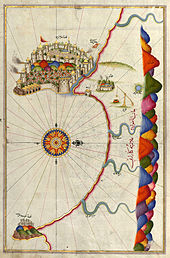
Finds in the nearby
The
With the spread of
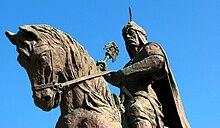
Following the
At the
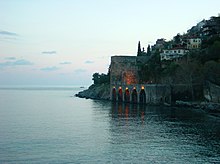
Trade in the region was negatively impacted by the development of an oceanic route from Europe around Africa to India, and in the tax registers of the late sixteenth century, Alanya failed to qualify as an urban center.
After World War I, Alanya was nominally
Geography
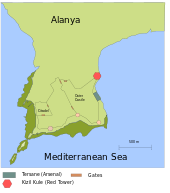
Located on the Gulf of Antalya on the Anatolian coastal plain of Pamphylia, the town is situated between the Taurus Mountains to the north and the Mediterranean Sea, and is part of the Turkish Riviera, occupying roughly 70 kilometres (43 mi) of coastline.[36] From west to east, the Alanya district is bordered by the Manavgat district along the coast, the mountainous Gündoğmuş inland, Hadim and Taşkent in the Province of Konya, Sarıveliler in the Province of Karaman, and the coastal Gazipaşa district.[37] Manavgat is home to the ancient cities of Side and Selge. East of the city, the Dim River flows from the mountains in Konya on a south-west route into the Mediterranean.[citation needed]
The Pamphylia plain between the sea and the mountains is an isolated example of an

The town is divided east–west by a rocky
Climate
Alanya has a typical
| Climate data for Alanya (1970–2011) | |||||||||||||
|---|---|---|---|---|---|---|---|---|---|---|---|---|---|
| Month | Jan | Feb | Mar | Apr | May | Jun | Jul | Aug | Sep | Oct | Nov | Dec | Year |
| Record high °C (°F) | 23.2 (73.8) |
25.0 (77.0) |
28.1 (82.6) |
30.7 (87.3) |
35.4 (95.7) |
37.8 (100.0) |
40.8 (105.4) |
39.6 (103.3) |
37.2 (99.0) |
34.9 (94.8) |
30.0 (86.0) |
24.7 (76.5) |
40.8 (105.4) |
| Mean daily maximum °C (°F) | 16.2 (61.2) |
16.3 (61.3) |
18.3 (64.9) |
21.1 (70.0) |
24.7 (76.5) |
28.7 (83.7) |
31.5 (88.7) |
32.1 (89.8) |
30.2 (86.4) |
26.5 (79.7) |
21.5 (70.7) |
17.8 (64.0) |
23.7 (74.7) |
| Daily mean °C (°F) | 11.8 (53.2) |
11.9 (53.4) |
13.8 (56.8) |
16.9 (62.4) |
20.9 (69.6) |
25.1 (77.2) |
27.8 (82.0) |
28.0 (82.4) |
25.4 (77.7) |
21.2 (70.2) |
16.4 (61.5) |
13.2 (55.8) |
19.4 (66.9) |
| Mean daily minimum °C (°F) | 8.6 (47.5) |
8.5 (47.3) |
10.1 (50.2) |
13.0 (55.4) |
16.7 (62.1) |
20.5 (68.9) |
23.3 (73.9) |
23.7 (74.7) |
21.2 (70.2) |
17.4 (63.3) |
13.0 (55.4) |
10.0 (50.0) |
15.5 (59.9) |
| Record low °C (°F) | −1.9 (28.6) |
−2.2 (28.0) |
0.9 (33.6) |
4.0 (39.2) |
9.8 (49.6) |
13.3 (55.9) |
16.9 (62.4) |
14.1 (57.4) |
13.2 (55.8) |
9.5 (49.1) |
2.9 (37.2) |
0.4 (32.7) |
−2.2 (28.0) |
| Average precipitation mm (inches) | 199.0 (7.83) |
149.4 (5.88) |
97.8 (3.85) |
70.7 (2.78) |
32.4 (1.28) |
8.5 (0.33) |
4.5 (0.18) |
2.7 (0.11) |
17.5 (0.69) |
98.5 (3.88) |
182.9 (7.20) |
231.2 (9.10) |
1,095.1 (43.11) |
| Average rainy days | 13.8 | 11.6 | 9.5 | 8.5 | 4.4 | 1.5 | 0.4 | 0.5 | 2.1 | 6.6 | 9.9 | 13.0 | 81.8 |
| Average relative humidity (%)
|
57 | 57 | 61 | 63 | 66 | 66 | 64 | 65 | 58 | 55 | 59 | 60 | 61 |
| Mean monthly sunshine hours | 127.1 | 127.1 | 192.2 | 219.0 | 288.3 | 348.0 | 325.5 | 316.2 | 273.0 | 220.1 | 159.0 | 133.3 | 2,728.8 |
| Mean daily sunshine hours | 4.1 | 4.5 | 6.2 | 7.3 | 9.3 | 11.6 | 10.5 | 10.2 | 9.1 | 7.1 | 5.3 | 4.3 | 7.5 |
| Source 1: Turkish State Meteorological Service[45] | |||||||||||||
| Source 2: Weather2 [46] | |||||||||||||
| Jan | Feb | Mar | Apr | May | Jun | Jul | Aug | Sep | Oct | Nov | Dec |
|---|---|---|---|---|---|---|---|---|---|---|---|
| 17.8 °C (64.0 °F) | 16.9 °C (62.4 °F) | 17.3 °C (63.1 °F) | 17.9 °C (64.2 °F) | 21.2 °C (70.2 °F) | 25.3 °C (77.5 °F) | 27.9 °C (82.2 °F) | 29.0 °C (84.2 °F) | 27.7 °C (81.9 °F) | 24.9 °C (76.8 °F) | 21.2 °C (70.2 °F) | 19.0 °C (66.2 °F) |
Main sights

On the peninsula stands
The
Atatürk's House and Museum, from his short stay in the city on February 18, 1935, is preserved in its historic state and is an example of the interior of a traditional Ottoman villa, with artifacts from the 1930s. The house was built between 1880 and 1885 in the "karniyarik" (stuffed eggplant) style. Bright colors and red roofs are often mandated by neighborhood councils, and give the modern town a pastel glow. Housed in a 1967 Republican era building, The Alanya Museum is inland from Damlataş Beach.[53]
Alanya is a member of the Norwich-based European Association of Historic Towns and Regions.[54] In 2009, city officials filed to include Alanya Castle and Tersane as UNESCO World Heritage Sites, and were named to the 2009 Tentative List.[55][56]
Demographics
| Year | District | City |
|---|---|---|
| 1893[34] | 37914 | |
| 1965[57] | 43459 | 12436 |
| 1970[58] | 53552 | 15011 |
| 1975[59] | 63235 | 18520 |
| 1980[60] | 74148 | 22190 |
| 1985[61] | 87080 | 28733 |
| 1990[62] | 129106 | 52460 |
| 1997[63] | 235884 | 117311 |
| 2007[64][65] | 226236 | 91713 |
| 2012[64][65] | 264692 | 104573 |
| 2017[64] | 299464 | - |
| 2022[64] | 364180 | - |
From only 87,080 in 1985,
The city is home to many migrants from the
| Foreigners in Alanya | ||
| 1 | 10,000 | |
| 2 | 3,821 | |
| 3 | 3,000 | |
| 4 | 769 | |
| 5 | 634 | |
| 6 | 521 | |
| 7 | 475 | |
| 8 | 383 | |
| 9 | 303 | |
| 10 | 297 | |
The city is nearly 99%
Education and health

The city has 95%
In 2005,
Culture
Alanya's culture is a subculture of the larger

The Alanya Chamber Orchestra, formed of members of the Antalya State Opera and Ballet, gave its inaugural performance on December 7, 2007.
Government
This section needs to be updated. (November 2020) |
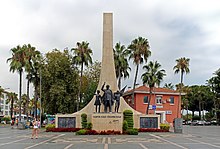
Alanya was set up as a municipality in 1872, electing its first mayor in 1901. Today, Alanya is governed by a mayor and a municipality council made up of thirty-seven members.[100] Twenty-four councilors are from the centre-left Republican People's Party, nine are from the far-right Nationalist Movement Party, and four are of the Good Party. Mayor Osman Tarık Özçelik of the Republican People's Party was elected in 2024 by unseating the incumbent Adem Murat Yücel, who had previously been mayor since 2014.[101] Elections are held every five years, with the next to be held in March 2029.

Alanya District is divided up into 17 municipalities, including the city center, and 92 villages.[102] Alanya is greatly influenced by the provincial government in Antalya, and the national government in Ankara, which appoints a governor for the district, currently Dr. Hulusi Doğan.[103] Although Alanya has been part of Antalya Province since the Ottoman Empire, many local politicians have advocated a separate Alanya Province, a position supported by associations of foreign residents.[104]
Nationally, in the
Economy
This section needs to be updated. (November 2020) |
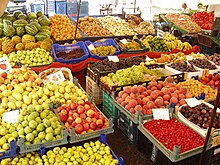
The tourist industry in Alanya is worth just under 1.1 billion
Despite the seaside location, few residents make their living on the sea, and fishing is not a major industry. In the early 1970s, when fish stocks ran low, a system of rotating access was developed to preserve this sector.[109] This innovative system was part of Elinor Ostrom's research on economic governance which led to her 2009 Nobel Prize in Economics.[110] In 2007, locals protested the establishment of some larger chain supermarkets and clothing stores, which have opened branches in Alanya.[111]
Beginning in 2003, with the provisional elimination of restrictions on
Tourism
This section needs to be updated. The reason given is: covid-19. (June 2020) |
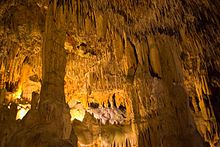
Since the first modern
Other outdoor tourist activities include
Media
Alanya has 10 local daily newspapers.[36] One of these is Yeni Alanya, which includes the news and lifestyles magazine Orange and is available in English, German and Turkish. Two native German language newspapers are published in Alanya, the Aktuelle Türkei Rundschau and Alanya Bote for the community of German speaking residents and visitors. A monthly magazine Hello Alanya published in Alanya for foreigners, appearing in English and Dutch.[123] The free regional newspaper, Riviera News, is printed in English and is widely available in Alanya.
Five radio stations broadcast from the city.[36] Alanya FM Radyo broadcasts on 106.0 FM and is partnered with Radio Flash, on 94.0 FM, both broadcasting popular music.[124] Other stations include Alanya RadyoTime on 92.3 FM, which broadcasts a variety of Turkish music, news, and talk programming.[125] Two television stations are local to Alanya, Kanal Alanya, and Alanya Televizyonu, abbreviated ATV, which is partnered with Alanya RadyoTime.[126][127]
Transportation
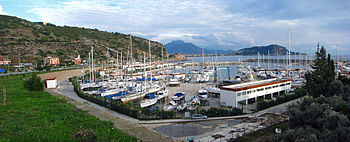
The
There are bus and
Sports
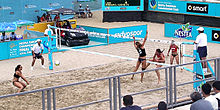
Alanya is home to a

Alanya's waterfront location makes it suitable for certain events, and is perhaps most famous for its annual
The city is also a frequent host to national events, such as the annual beach
Neighbourhoods
There are 103
- Akçatı
- Akdam
- Alacami
- Alara
- Aliefendi
- Asmaca
- Avsallar
- Bademağacı
- Basırlı
- Başköy
- Bayırköy
- Bayırkozağacı
- Bektaş
- Beldibi
- Beyreli
- Bıçakçı
- Bucakköy
- Burçaklar
- Büyükhasbahçe
- Büyükpınar
- Çakallar
- Çamlıca
- Çarşı
- Cikcilli
- Çıplaklı
- Cumhuriyet
- Değirmendere
- Demirtaş
- Dereköy
- Dinek
- Elikesik
- Emişbeleni
- Fakırcalı
- Fığla
- Gözübüyük
- Gözüküçüklü
- Güllerpınarı
- Gümüşgöze
- Gümüşkavak
- Güneyköy
- Güzelbağ
- Hacet
- Hacıkerimler
- Hacımehmetli
- Hisariçi
- Hocalar
- İmamlı
- İncekum
- İshaklı
- İspatlı
- Kadıpaşa
- Karakocalı
- Karamanlar
- Karapınar
- Kargıcak
- Kayabaşı
- Keşefli
- Kestel
- Kızılcaşehir
- Kızlarpınarı
- Kocaoğlanlı
- Konaklı
- Küçükhasbahçe
- Kuzyaka
- Mahmutlar
- Mahmutseydi
- Oba
- Obaalacami
- Okurcalar
- Orhanköy
- Ortakonuş
- Öteköy
- Özvadi
- Paşaköy
- Payallar
- Saburlar
- Sapadere
- Saray
- Şekerhane
- Seki
- Şıhlar
- Soğukpınar
- Sugözü
- Süleymanlar
- Taşbaşı
- Tepe
- Tırılar
- Tophane
- Toslak
- Tosmur
- Türkler
- Türktaş
- Uğrak
- Uğurlu
- Üzümlü
- Uzunöz
- Yalçı
- Yasırali
- Yaylakonak
- Yaylalı
- Yenice
- Yeniköy
- Yeşilöz
International relations
The most significant tie is with the city of Nea Ionia, where many of Alanya's Christians were resettled in 1923 after the Treaty of Lausanne. Alanya is twinned with:[150]
 Dergachyovsky District, Russia
Dergachyovsky District, Russia Fushun, China
Fushun, China Geoagiu, Romania
Geoagiu, Romania Gladbeck, Germany
Gladbeck, Germany Goa, India
Goa, India Keszthely, Hungary
Keszthely, Hungary Mahdia, Tunisia
Mahdia, Tunisia Ankara, Turkey
Ankara, Turkey Nea Ionia, Greece
Nea Ionia, Greece Murmansk, Russia
Murmansk, Russia Oer-Erkenschwick, Germany
Oer-Erkenschwick, Germany Rovaniemi, Finland
Rovaniemi, Finland Šilutė, Lithuania
Šilutė, Lithuania South-Eastern AO (Moscow), Russia
South-Eastern AO (Moscow), Russia Špindlerův Mlýn, Czech Republic
Špindlerův Mlýn, Czech Republic Talsi, Latvia
Talsi, Latvia Trakai, Lithuania
Trakai, Lithuania Wodzisław Śląski, Poland
Wodzisław Śląski, Poland Wronki, Poland
Wronki, Poland Zelenogorsk, Russia
Zelenogorsk, Russia Borås, Sweden
Borås, Sweden
Friendly cities
Notable residents
- Mevlüt Çavuşoğlu, Turkish diplomat and politician; former Minister of Foreign Affairs of Turkey
See also
References
- ^ TÜİK. Retrieved 22 May 2023.
- ^ Büyükşehir İlçe Belediyesi, Turkey Civil Administration Departments Inventory. Retrieved 8 June 2023.
- ^ "İl ve İlçe Yüz ölçümleri". General Directorate of Mapping. Retrieved 22 May 2023.
- ^ "Alanya". citypopulation.de. Retrieved 14 June 2023.
- ^ "CHP, Alanya'da 74 yıl sonra kazandı".
- ^ a b c d "Alanya – Korekesion". Daily Life, Culture, and Ethnography of Antalya. Antalya Valiliği. February 6, 2008. Archived from the original on August 24, 2007. Retrieved September 7, 2008.
- ^ "Coracesium". Catholic Hierarchy. October 7, 2013. Retrieved January 18, 2015.
- ^ JSTOR 1523182.
- ^ S2CID 140560594.
- ^ Yetkin, Haşim (1990). Dünden Bugüne Alanya. Antalya: Yetkin Dağitim. Archived from the original on May 13, 2008. Retrieved March 10, 2008.
- ^ "Alaiye's Becoming Alanya". Alanyanın Web Sitesi. 2008. Archived from the original on July 29, 2010. Retrieved August 1, 2008.
- ^ a b c d e "The History of Alanya". Ministry of Tourism. Retrieved September 7, 2008.
- ^ "Relics of a 5,000-year-old port found in southern Turkey". World Bulletin. August 24, 2011. Retrieved August 29, 2011.
- ^ S2CID 131468949.
- Turkish Daily News. Archived from the originalon April 18, 2013. Retrieved May 2, 2009.
- S2CID 164178570.
- JSTOR 639682.
- ^
 Smith, William, ed. (1854–1857). "Cilicia". Dictionary of Greek and Roman Geography. London: John Murray.
Smith, William, ed. (1854–1857). "Cilicia". Dictionary of Greek and Roman Geography. London: John Murray.
- JSTOR 3632602.
- ^ Pius Bonifacius Gams, Series episcoporum Ecclesiae Catholicae, Leipzig 1931, p. 450
- ^ Michel Lequien, Oriens christianus in quatuor Patriarchatus digestus, Paris 1740, Vol. I, coll. 1007-1008
- ^ Raymond Janin, v. Coracesium, in Dictionnaire d'Histoire et de Géographie ecclésiastiques, vol. XIII, Paris 1956, col. 804
- ^ Sophrone Pétridès, v. Coracesium, Catholic Encyclopedia, vol. IV, New York 1908
- ISBN 978-88-209-9070-1), p. 874
- JSTOR 1291369.
- JSTOR 1523181.
- JSTOR 1523237.
- ^ JSTOR 3596293.
- S2CID 246045886.
- ^ "Hamid Dynasty". Encyclopædia Britannica. 2007. Retrieved January 29, 2007.
- JSTOR 3632058.
- ^ "History of Kalkan". Five Star Hotels Antalya. 2006. Archived from the original on 16 February 2008. Retrieved February 24, 2008.
- S2CID 144015203.
- ^ S2CID 162337621.
- ^ a b Hakları, Telif (2002). "Belediye Tarihi". Archived from the original on 7 September 2008. Retrieved September 7, 2008.
- ^ a b c d e f g "Rakamlarla Alanya". Alanya Chamber of Commerce. 2005. Retrieved September 7, 2008.
- ISSN 1302-1796. Archived from the originalon February 13, 2012. Retrieved February 23, 2008.
- ^ World Wildlife Fund, ed. (2001). "Eastern Mediterranean conifer-sclerophyllous-broadleaf forests". WildWorld Ecoregion Profile. National Geographic Society. Archived from the original on 2010-03-08. Retrieved September 7, 2008.
- .
- .
- ^ "Kleopatra Beach". www.alanya.cc. 2007. Archived from the original on 2011-07-06. Retrieved September 7, 2008.
- ^ "Summer sun for southern beaches, eastern Anatolia remains icy". Today's Zaman. February 9, 2008. Retrieved February 10, 2008.[permanent dead link]
- ^ "Waterspouts in Alanya". Istanbul Journal of Weather. Weather Underground. October 19, 2006. Retrieved February 22, 2008.
- ^ "Turkey Statistical Yearbook" (PDF). State Institute of Statistics. 2004. Archived from the original (PDF) on 10 September 2008. Retrieved September 7, 2008.
- ^ "İl ve İlçelerimize Ait İstatistiki Veriler- Meteoroloji Genel Müdürlüğü". Dmi.gov.tr. December 2012. Archived from the original on 2012-06-04. Retrieved 2019-01-14.
- ^ "July Climate History for Alanya | Local | Turkey". Myweather2.com. October 2011. Retrieved 2013-03-25.
- ^ "Monthly Alanya water temperature chart". seatemperature.org. Retrieved 23 August 2013.
- ^ "Ancient Church needs support". Orange Alanya. April 15, 2007. Archived from the original on July 18, 2011. Retrieved May 2, 2009.
- ^ a b "Historical Places". Alanya'nın Resmi Web Sitesi. 2007. Archived from the original on 8 August 2008. Retrieved September 7, 2008.
- ^ "Kızıl Kule (Red Tower)". Alanya Cities and Historical Sites. Turkish Class. 2007. Archived from the original on 6 October 2008. Retrieved September 7, 2008.
- S2CID 246047816.
- ^ Kutay, Kürşat (June 23, 2009). "Alarahan caravanserai now a major attraction". Hürriyet. Retrieved June 28, 2009.
- ^ Turkish Daily News. Archived from the originalon April 18, 2013. Retrieved May 2, 2009.
- ^ "Turkey". Association of Historic Towns of Turkey. European Association of Historic Towns and Regions. Archived from the original (DOC) on 2008-09-10. Retrieved September 7, 2008.
- ^ "Alanya in line for 'World Heritage' tag". Hürriyet. February 4, 2009. Retrieved February 5, 2009.
- ^ "5 more sites from Turkey on UNESCO's World Heritage Tentative List". Today's Zaman. April 24, 2009. Archived from the original on 26 April 2009. Retrieved April 24, 2009.
- ^ "1965 General Census" (PDF) (in Turkish). Turkish Statistical Institute. 1965. Archived (PDF) from the original on 31 May 2022.
- ^ "1970 General Census" (PDF) (in Turkish). Turkish Statistical Institute. 1970. Archived (PDF) from the original on 10 August 2022.
- ^ "1975 General Census" (PDF) (in Turkish). Turkish Statistical Institute. 1975. Archived (PDF) from the original on 10 August 2022.
- ^ "1980 General Census" (PDF) (in Turkish). Turkish Statistical Institute. 1980. Archived (PDF) from the original on 17 June 2022.
- ^ a b "1985 General Census" (PDF) (in Turkish). Turkish Statistical Institute. 1986. Archived (PDF) from the original on 22 May 2021.
- ^ "1990 General Census" (PDF) (in Turkish). Turkish Statistical Institute. 1991. Archived (PDF) from the original on 31 August 2021.
- ^ "1997 Population Count" (PDF) (in Turkish). Turkish Statistical Institute. 1999. Archived (PDF) from the original on 30 October 2022.
- ^ a b c d e "Population Of SRE-1, SRE-2, Provinces and Districts". TÜIK. Retrieved 10 January 2024.
- ^ a b "Population Of Municipalities, Villages And Quarters". TÜIK. Retrieved 10 January 2024.
- ^ Turkish Daily News. Archived from the originalon April 18, 2013. Retrieved May 2, 2009.
- ^ "Foreign interest in Alanya on the rise". Today's Zaman. May 1, 2007. Archived from the original on May 24, 2008. Retrieved September 7, 2008.
- ^ a b Yilmaz, Fatih; Ahmet Yeşhil Fethiye (May 1, 2008). "Property prices fall with cancellation of law on property sales to foreigners". Today's Zaman. Archived from the original on May 2, 2008. Retrieved May 3, 2008.
- ^ Yeşil, Ahmet (February 10, 2007). "Number of foreigners owning property in Turkey rapidly increasing". Today's Zaman. Archived from the original on September 27, 2012. Retrieved September 7, 2008.
- ^ Stevens, Kristen (December 19, 2006). "Migration matters in globalized Turkey". Turkish Daily News. Archived from the original on July 7, 2012. Retrieved May 2, 2009.
- ^ Coşkun, Yadigar (2006). "Analyzing the Aspects of International Migration in Turkey" (PDF). Migration Research Program at the Koç University. Archived (PDF) from the original on July 11, 2007. Retrieved September 7, 2008.
- ^ "Yürüks struggle to keep traditions". Hürriyet. June 14, 2009. Retrieved June 14, 2009.
- Turkish Daily News. Archived from the originalon July 1, 2012. Retrieved May 2, 2009.
- ^ a b "Turkissa asuva suomalainen liiran syöksystä: Turisti tuntee olonsa rikkaaksi, paikallinen kauhistelee kallista lihaa – "Nyt joudutaan todella jo miettimään, mitä ruokapöytään pannaan"". Yle Uutiset.
- ^ "Number of Arriving-Departing Foreigner and Citizens September 2022". ktb.gov.tr.
- ^ "Foreign interest in Alanya on the rise". www.todayszaman.com. 24 May 2008. Archived from the original on 2008-05-24. Retrieved 2020-11-03.
- ^ "Alanya: Sweet home for expats". www.aa.com.tr. Retrieved 2020-11-03.
- ^ AA, Daily Sabah with (July 26, 2017). "Germans in Alanya want to see quick recovery in relations". Daily Sabah.
- ^ "Church work on the Turkish Riviera". Evangelical Church in Germany. January 2004. Archived from the original on May 19, 2008. Retrieved September 7, 2008.
- ^ "Historic Orthodox Church in south Turkey to be renovated after 142 years". BGN News. March 16, 2015. Archived from the original on April 11, 2015. Retrieved April 5, 2015.
- Turkish Daily News. Archived from the originalon July 7, 2012. Retrieved May 2, 2009.
- Doğuş İnşaat. 2004. Retrieved February 17, 2008.[dead link]
- ^ "Alanya İşletme Fakültesi". Akdeniz University. July 5, 2006. Archived from the original on May 23, 2008. Retrieved September 7, 2008.
- ^ "International Tourism Conference". February 6, 2008. Archived from the original on June 25, 2008. Retrieved September 7, 2008.
- ^ "Mediterranean City of Alanya to Get Its First Private University". Hürriyet Daily News. August 31, 2010. Retrieved September 8, 2010.
- ^ Hasson, Orin (December 18, 2007). "The McGhee Center for Eastern Mediterranean Studies". Archived from the original on 2 March 2008. Retrieved February 24, 2008.
- ^ "Baskent University Alanya Hospital". Başkent University. February 14, 2008. Archived from the original on 28 March 2008. Retrieved February 17, 2008.
- ^ "Health Services in Alanya". T.C. Alanya Kaymakamlığı. 2007. Archived from the original on August 11, 2011. Retrieved February 17, 2008.
- ^ "Alanya is Getting ready For The Tourim Festival". alanya.com.tr. May 2, 2007. Archived from the original on 2012-04-12. Retrieved February 16, 2008.
- ^ "Festivals". Ministry of Culture and Tourism. 2005. Retrieved September 7, 2008.[dead link]
- ^ "Festivals". Ezop Travel. 2007. Archived from the original on 30 January 2008. Retrieved February 16, 2008.
- ^ "Holiday town Alanya to host tiny jazz festival". Today's Zaman. October 7, 2008. Archived from the original on September 27, 2012. Retrieved October 7, 2008.
- ^ "Alanya showed an interest in Chamber Orkestra". alanya.com.tr. December 8, 2007. Archived from the original on 2012-04-12. Retrieved February 16, 2008.
- ^ "4th of Alanya Stone Sculpture Semposium". alanya.com.tr. October 30, 2007. Archived from the original on 2012-04-12. Retrieved February 16, 2008.
- ^ "Holiday resort hosts documentary festival". Today's Zaman. April 20, 2009. Archived from the original on January 8, 2016. Retrieved April 20, 2009.
- ^ "Alanya Müzesi". Fodor's. 2008. Retrieved February 17, 2008.
- ^ "500 Norwegians Attend Ceremonies In Alanya To Mark National Day Of Norway". Turkish Press. May 18, 2008. Archived from the original on June 5, 2011. Retrieved September 7, 2008.
- ^ Evren, Melik (December 21, 2010). "Antalya's first Christmas market set up in Alanya". Today's Zaman. Archived from the original on October 12, 2012. Retrieved January 3, 2011.
- ^ "Nevruz'da İranlı sürprizi". Yeni Alanya (in Turkish). March 29, 2009. Archived from the original on July 18, 2011. Retrieved April 20, 2009.
- ^ "Alanya Belediyesi'nin meclis üyeleri belli oldu! 37 kişilik Meclis'te kimler var?". Akdeniz Gerçek. 2024. Archived from the original on April 4, 2024. Retrieved April 2, 2024.
- ^ "Alanya'nın Yeni Lideri Osman Tarık Özçelik". Yeni Alanya (in Turkish). April 1, 2024. Retrieved April 1, 2024.
- ^ "Nüfusu ve Demografik Boyutları". Alanya municipality. 2002. Archived from the original on June 24, 2008. Retrieved September 7, 2008.
- ^ "Alanya Kaymakami". T.C. Alanya Kaymakamlığı. 2007. Archived from the original on 2 February 2008. Retrieved February 24, 2008.
- ^ "Foreigners call on authorities to grant Alanya province status". Today's Zaman. December 30, 2010. Archived from the original on December 31, 2010. Retrieved January 3, 2011.
- NTV Turkey. 2007. Archived from the originalon 21 September 2008. Retrieved September 7, 2008.
- ^ "Mr Mevlüt Çavuşoğlu". Council of Europe. 2007. Archived from the original on May 27, 2009. Retrieved May 2, 2009.
- ^ "Economic Structure of Antalya". Antalya Chamber of Commerce and Industry. 2005. Archived from the original on 2019-08-21. Retrieved 2012-01-08.
- ^ Yeşil, Ahmet (April 30, 2008). "Alanya farmers turn to greengage plum, avocado production". Today's Zaman. Archived from the original on September 27, 2012. Retrieved April 30, 2008.
- ^ "Halting degradation of natural resources". Food and Agriculture Organization. 1996. Retrieved September 7, 2008.
- ^ "Fishermen in Alanya proud to be a part of the Nobel prize". www.alanyaproperties.com. Alanya Properties. Archived from the original on December 28, 2010. Retrieved June 22, 2010.
- Turkish Daily News. Archived from the originalon April 18, 2013. Retrieved May 2, 2009.
- Turkish Daily News. May 1, 2008. Archived from the originalon July 1, 2012. Retrieved September 7, 2008.
- ^ Yeşil, Ahmet (March 14, 2009). "Foreigners no longer buying real estate for profit in Alanya". Today's Zaman. Archived from the original on December 12, 2013. Retrieved March 14, 2009.
- ^ Yeşil, Ahmet (October 29, 2007). "Alanya's property sector moribund". Today's Zaman. Archived from the original on December 12, 2013. Retrieved September 7, 2008.
- ^ "FAQ". Tora Villa Real Estate. March 2005. Archived from the original on July 17, 2011. Retrieved September 7, 2008.
- ^ Leone, Stacie (May 2006). "Burgeoning Alanya". Turkey-Now. Archived from the original on 2007-10-15. Retrieved September 7, 2008.
- Turkish Daily News. June 26, 2007. Archived from the originalon July 14, 2012. Retrieved May 2, 2009.
- ^ "Damlataş Cave". Alanya.com.tr. May 20, 2006. Archived from the original on 2008-02-16. Retrieved February 24, 2008.
- The Chronicle. Archived from the originalon March 7, 2011. Retrieved June 22, 2010.
- Turkish Daily News. Archived from the originalon July 1, 2012. Retrieved May 2, 2009.
- ^ "Europe's biggest water park begins new season". Today's Zaman. May 5, 2009. Archived from the original on January 8, 2016. Retrieved May 5, 2009.
- Turkish Daily News. October 22, 2008. Archived from the originalon July 7, 2012. Retrieved May 2, 2009.
- ^ "Hello Turkey Magazine". 2008. Archived from the original on April 1, 2011. Retrieved February 24, 2008.
- ^ "Alanyanin Dünyaya Açilan Kapisi". April 5, 2007. Archived from the original on October 14, 2008. Retrieved February 22, 2008.
- ^ "Alanya RadyoTime". 2007. Archived from the original on 7 March 2008. Retrieved 22 February 2008.
- ^ "Radio and Television". Alanya Guide. 2008. Archived from the original on February 7, 2019. Retrieved May 2, 2009.
- ^ "ATV Yayin Akişi". Alanya Televizyonu. 2007. Archived from the original on 2009-09-07.
- ^ a b "Alanya Marina, Londra'da Tanıtıldı". Haberler. January 17, 2014. Retrieved February 7, 2014.
- Hürriyet Daily News and Economic Review. Doğan News Agency. Retrieved March 21, 2010.
- ^ "Train travel within Turkey". The Man in Seat Sixty-One. February 21, 2008. Archived from the original on 23 January 2008. Retrieved February 24, 2008.
- ^ Hall, Tom (October 26, 2008). "Ask Tom". The Observer. Archived from the original on 30 October 2008. Retrieved October 27, 2008.
- ^ Gibson, Rebecca (November 22, 2013). "Passenger rise in Alanya". Cruise and Ferry. Retrieved November 29, 2013.
- Turkish Daily News. December 28, 2007. Archived from the originalon July 1, 2012. Retrieved May 2, 2009.
- ^ "19th Eastern Mediterranean Rally Yachts In Murefte". Turkish Press. April 27, 2008. Archived from the original on December 28, 2017. Retrieved September 7, 2008.
- ^ "Turkey's 37th Marina To Be In Service Next Year". Turkish Press. May 29, 2008. Archived from the original on December 28, 2017. Retrieved September 7, 2008.
- Turkish Daily News. Archived from the originalon April 18, 2013. Retrieved May 2, 2009.
- ^ "Alanya 15,000-seat, closed-roof stadium to open next year". Today's Zaman. April 12, 2007. Archived from the original on May 24, 2008. Retrieved September 7, 2008.
- ^ "Olympic Swimming Pool is at Sportmen's Service". Alanya municipality. June 27, 2007. Archived from the original on July 7, 2007. Retrieved September 7, 2008.
- ^ "The Sport Facilities in our Town". T.C. Alanya Kaymakamlığı. 2007. Archived from the original on August 11, 2011. Retrieved February 17, 2008.
- ^ Tuncer, Yasin (November 2, 2008). "Turkey has great potential for triathlons". Today's Zaman. Archived from the original on August 8, 2014. Retrieved November 2, 2008.
- ^ "Russians sweep swimming marathon in Russia". Hürriyet. Doğan News Agency. October 29, 2009. Archived from the original on 2 November 2009. Retrieved November 2, 2009.
- ^ "Alanya hosts pentathlon event". Hürriyet. Doğan News Agency. September 9, 2009. Retrieved September 15, 2009.
- ^ "ECT 2005 - Alanya (TUR)". 2005. Archived from the original on August 25, 2007. Retrieved September 7, 2008.
- Turkish Daily News. Archived from the originalon July 1, 2012. Retrieved May 2, 2009.
- ^ "The Prevailing Party in Beach Handball is the Turkish Teams". Alanya Municipality. July 2, 2007. Archived from the original on July 22, 2011. Retrieved May 2, 2009.
- ^ "First summit finish and stronger lineup for Presidential Tour of Turkey". Velonation. March 3, 2012. Retrieved March 5, 2012.
- ^ "12th International Mountain Bike Cup to be held in Turkey". Xinhua News Agency. September 30, 2008. Archived from the original on October 4, 2008. Retrieved May 2, 2009.
- ^ "Turkey To Host U.E.C. 2010 Congress". Turkish Press. March 3, 2008. Archived from the original on August 22, 2017. Retrieved September 7, 2008.
- ^ Mahalle, Turkey Civil Administration Departments Inventory. Retrieved 22 May 2023.
- ^ "Kardeş Şehirler". alanya.bel.tr (in Turkish). Alanya. Retrieved 2020-01-18.
Further reading
- OCLC 7230223.
- Redford, Scott. Landscape and the state in medieval Anatolia: Seljuk gardens and pavilions of Alanya, Turkey. ISBN 1-84171-095-4




